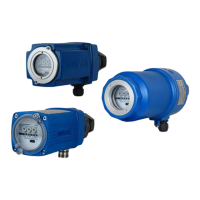4 | Functional safety
D-LX 201/721
29
The values in the table apply for a 100% Proof Test Coverage (PTC). The proof test
should always be performed twice as frequently as the application-specific rate of de-
mand, so for example at least twice a year with a rate of demand of once a year.
4.6 Proof test for the low demand mode
You may carry out both the simple and extended proof tests (see below) yourself. Use
the test kit for D-LX 200/720 and D‑LX201/721 for this purpose. Note the detailed op-
erating instructions for the test kit.
Simple proof test
Testing with the test kit's light source involves automated tests on the following points,
in combination with a program on a PC:
● Frequency behaviour
● Intensity range
● Amplification control
● Flame relay switching capacity
● Measurement of the Flame Failure Detection Time (FFDT)
● Range switching
● Analogue output
By performing this test a Proof Test Coverage (PTC) of 23% is achieved.
Extended proof test
The automated test can be extended by means of a relay tester also included in the
test kit. The relay tester tests the independence of the two flame relay contacts that
are internally connected in series.
This extended test increases the Proof Test Coverage (PTC) to 35%.
Proof test at the factory
Extended testing at the factory gives a Proof Test Coverage (PTC) of 37%.
PFD values for incomplete proof testing
The proof tests specified here are incomplete (PTC < 100%). In this case, the PFD
AVG
value depends on the PTC values, the interval (T1) for the proof test in years, and the
interval (T2) for the rate of demand of the safety function in years.
DURAG can provide you with a formula for this calculation. This will allow you to cal-
culate PFD
AVG
based on these parameters. The following figure shows the calculation
formula for an example calculation:

